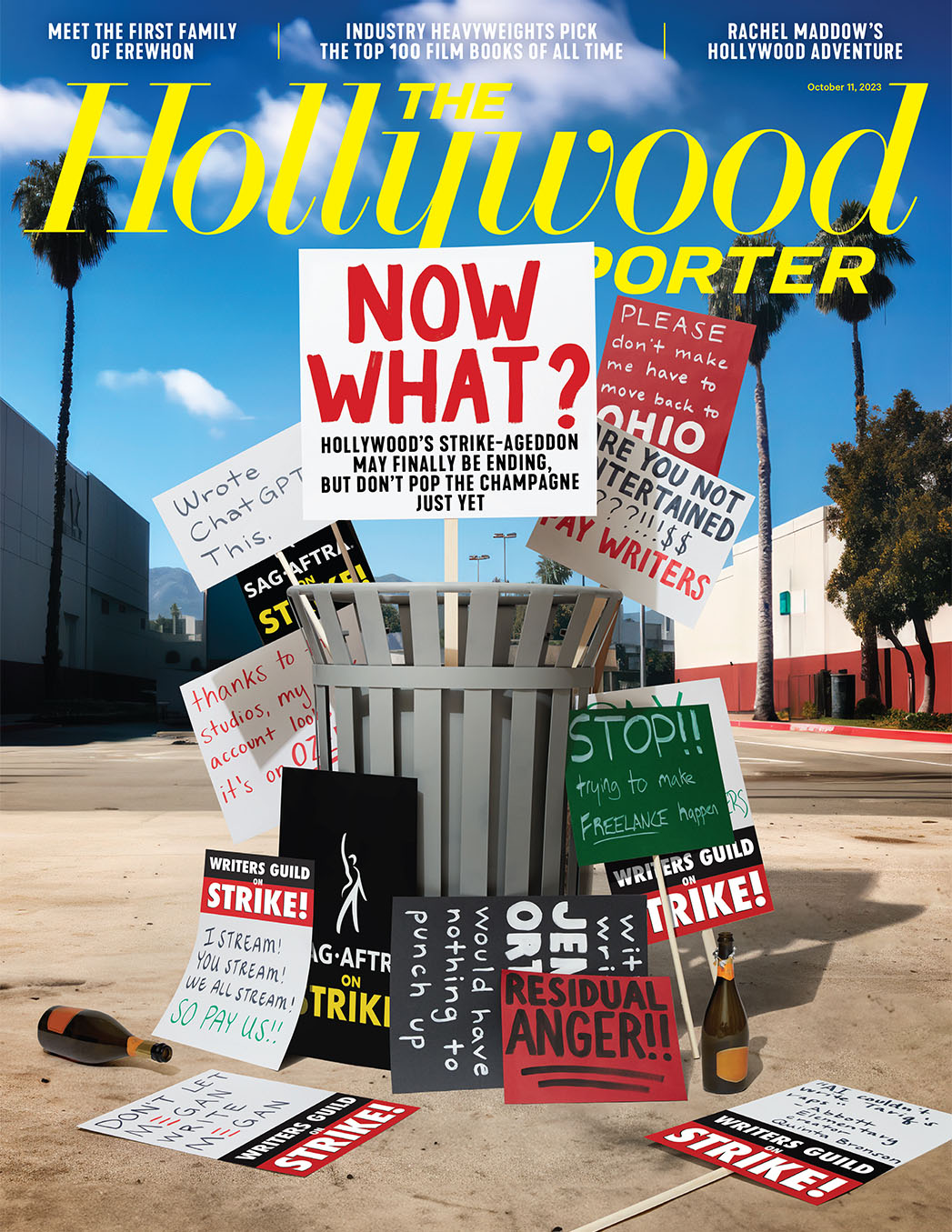Hollywood Production Grinds To Halt Amidst Joint Writers' And Actors' Strike

Table of Contents
Key Demands Fueling the Hollywood Strike
The Hollywood strike isn't simply about pay; it's a multifaceted battle encompassing fair compensation, the ethical use of artificial intelligence, and improved working conditions. These key demands are driving the unprecedented joint action by the WGA and SAG-AFTRA.
Fair Compensation and Residuals in the Streaming Era
The shift from traditional broadcast models to streaming has fundamentally altered the compensation landscape for writers and actors. While broadcast television offered residuals – payments made each time a show aired – streaming services largely operate on flat fees, significantly diminishing income for those whose work generates billions in revenue for streaming giants. This disparity forms the core of the argument for fair compensation.
- Example 1: A writer who worked on a successful broadcast sitcom in the past might have received substantial residuals for years after its initial run. The same writer working on a successful streaming show receives a drastically reduced, one-time payment.
- Example 2: A supporting actor in a hit streaming series receives a significantly smaller payment than their counterpart in a network television show, despite the streaming series having a much larger global audience.
- The fight for a fair share of streaming profits is central to the actors' and writers' demands, pushing for a model that more accurately reflects the value of their contributions in the digital age.
Concerns Regarding the Use of Artificial Intelligence (AI)
The rapid advancement of AI technology has introduced a new set of anxieties for writers and actors. The potential for AI to generate scripts, create digital replicas of actors, and ultimately replace human creativity fuels considerable concern. Both unions are seeking safeguards and regulations to protect their members from this technological disruption.
- Example 1: AI is being used to generate scripts, raising concerns about the potential for human writers to be replaced by algorithms.
- Example 2: The creation of "digital doubles" – AI-generated likenesses of actors – threatens to devalue the work of actors and erode their job security.
- The unions are demanding transparency and regulation around the use of AI in the entertainment industry, calling for agreements that protect the creative rights and livelihoods of actors and writers.
Working Conditions and Health & Safety
Long working hours, unreasonable demands, and inadequate safety protocols on set are longstanding concerns for actors and writers. The strike highlights the need for better working conditions and protection for those who create the content the world consumes.
- Example 1: Excessively long workdays without sufficient rest periods, leading to burnout and compromised performance.
- Example 2: Lack of adequate safety measures on set, resulting in accidents and injuries.
- The unions are pushing for mandated rest periods, improved health and safety regulations, and an overall reduction in the intense pressure placed on creative professionals.
Impact of the Joint Strike on Hollywood Production
The combined strike by the WGA and SAG-AFTRA has brought Hollywood to a standstill, impacting every aspect of the industry.
Production Shutdowns and Delays
The strike has resulted in the widespread shutdown of film and television production across Hollywood. Major film releases and television premieres have been postponed, creating a massive backlog.
- Example 1: Numerous late-night and daytime television shows have been indefinitely postponed, impacting both viewers and production staff.
- Example 2: Major blockbuster films have been delayed, causing significant financial losses for studios and distributors.
- The overall impact on production schedules is immense, with no clear timeline for a return to normal operations.
Economic Ripple Effects Beyond Hollywood
The economic consequences extend far beyond Hollywood's studio lots. Related industries, including catering, transportation, and post-production, are experiencing significant job losses and financial hardship.
- Example 1: Catering companies that rely on studio contracts are facing massive revenue losses.
- Example 2: Transportation services, such as trucking and equipment rentals, are experiencing sharp declines in demand.
- The ripple effect demonstrates the widespread economic interconnectedness within the entertainment ecosystem.
Impact on Streaming Services and Viewers
Streaming services are also feeling the pinch, with delayed release schedules and the potential for viewer dissatisfaction and subscription cancellations.
- Example 1: New seasons of popular streaming shows are delayed, affecting viewer engagement and potentially impacting subscriber retention.
- Example 2: The lack of new content could lead to a decline in subscriptions, causing financial losses for streaming platforms.
- The long-term impact on viewer behavior and streaming service revenue remains to be seen.
Potential Outcomes and Negotiations
The resolution of this Hollywood strike remains uncertain, with several possible scenarios playing out.
Possible Scenarios for Resolution
Reaching a compromise will require concessions from both the studios and the unions. Past precedents offer some insight into potential outcomes, but the scale and complexity of the current situation make prediction difficult.
- Example 1: A phased return to work, with agreements reached on specific issues before others.
- Example 2: A prolonged standoff, leading to further economic losses and potential changes in the industry's power dynamics.
- The negotiations are complex and involve many moving parts, including the unique challenges posed by the rise of streaming and AI.
Long-Term Implications for the Entertainment Industry
The long-term consequences of this Hollywood strike will be far-reaching. It has the potential to reshape labor relations, creative practices, and the very business models of the entertainment industry.
- Example 1: Changes to residuals models to better reflect streaming revenue.
- Example 2: Increased regulation around the use of AI in creative processes.
- The outcome of the strike will significantly affect the future of film and television production for years to come.
Conclusion
The Hollywood writers' and actors' strike represents a critical turning point for the entertainment industry. The unprecedented joint action highlights the need for fair compensation, improved working conditions, and ethical guidelines for the use of AI. The prolonged standstill carries substantial economic consequences and raises fundamental questions about the future of creative labor. The resolution of this conflict will not only shape the immediate future of Hollywood production but also redefine the landscape of entertainment for years to come. Staying informed about the ongoing developments in the Hollywood strike, the actors' strike, and the writers' strike is crucial to understanding the evolving dynamics of the film and television industry. Follow the news closely to stay updated on this crucial turning point for the entertainment world.

Featured Posts
-
 Yevrobachennya 2025 Khto Peremozhe Za Prognozom Konchiti Vurst
May 25, 2025
Yevrobachennya 2025 Khto Peremozhe Za Prognozom Konchiti Vurst
May 25, 2025 -
 Import Export Usa Impatto Dei Dazi Sui Prezzi Dell Abbigliamento
May 25, 2025
Import Export Usa Impatto Dei Dazi Sui Prezzi Dell Abbigliamento
May 25, 2025 -
 The Truth About Elon Musk And His Dogecoin Investments
May 25, 2025
The Truth About Elon Musk And His Dogecoin Investments
May 25, 2025 -
 Krasivaya Data 89 Svadeb Na Kharkovschine
May 25, 2025
Krasivaya Data 89 Svadeb Na Kharkovschine
May 25, 2025 -
 From Grace To Disaster 17 Celebrities Whose Reputations Imploded
May 25, 2025
From Grace To Disaster 17 Celebrities Whose Reputations Imploded
May 25, 2025
Latest Posts
-
 Myrtle Beach Officer Involved Shooting 1 Dead 11 Injured Sled Investigating
May 25, 2025
Myrtle Beach Officer Involved Shooting 1 Dead 11 Injured Sled Investigating
May 25, 2025 -
 How To Recognize And Respond To A Flash Flood Emergency
May 25, 2025
How To Recognize And Respond To A Flash Flood Emergency
May 25, 2025 -
 Carolina Country Music Fest 2025 Tickets Sold Out
May 25, 2025
Carolina Country Music Fest 2025 Tickets Sold Out
May 25, 2025 -
 Flood Warning Issued Follow Nws Safety Recommendations
May 25, 2025
Flood Warning Issued Follow Nws Safety Recommendations
May 25, 2025 -
 Surviving A Flash Flood Emergency Essential Tips And Advice
May 25, 2025
Surviving A Flash Flood Emergency Essential Tips And Advice
May 25, 2025
